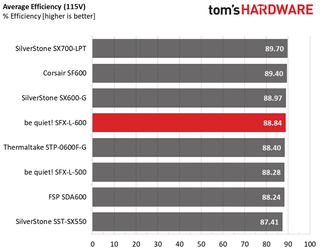be quiet! SFX L Power 600W PSU Review
Why you can trust Tom's Hardware
Performance, Value, Noise & Efficiency
Performance Rating
The following graph shows the SFX L Power 600W's total performance rating, comparing it to other units we have tested. To be more specific, the tested unit is shown as 100 percent, and every other unit's performance is shown relative to it.

This platform offers high overall performance. If ripple suppression was better, especially on the +12V rail, the SFX L Power 600W would land much closer to Corsair's excellent SF600.
Performance Per Dollar
The following chart may be the most interesting to many of you because it depicts the unit's performance-per-dollar score. We looked up the current price of each PSU on popular online shops and used those prices and all relative performance numbers to calculate the index. If the specific unit wasn't available in the United States, we searched for it in popular European Union shops, converting the listed price to USD (without VAT). Note that all of the numbers in the following graph are normalized by the rated power of each PSU.

With such a high price, be quiet!'s performance per dollar ratio isn't as competitive as the company would like.
Noise Rating
The graph below depicts the cooling fan's average noise over the PSU's operating range, with an ambient temperature between 30°C and 32°C (86°F to 89.6°F).

This is a wholly unobtrusive PSU, worthy of be quiet!'s name.
Efficiency Rating
The following graph shows the PSU's average efficiency throughout its operating range, with an ambient temperature close to 30°C.

Our efficiency measurements look good. Only the top-notch Corsair SF600 takes a clear lead.
MORE: Best Power Supplies
MORE: How We Test Power Supplies
MORE: All Power Supply Content
Current page: Performance, Value, Noise & Efficiency
Prev Page EMC Pre-Compliance Testing Next Page Final AnalysisStay on the Cutting Edge
Join the experts who read Tom's Hardware for the inside track on enthusiast PC tech news — and have for over 25 years. We'll send breaking news and in-depth reviews of CPUs, GPUs, AI, maker hardware and more straight to your inbox.
Aris Mpitziopoulos is a Contributing Editor at Tom's Hardware US, covering PSUs.

Get $400 off Asus' stunning 42-inch 4K OLED gaming monitor — 138Hz ROG Swift PG42UQ drops to $999

US investigates China's access to RISC-V — open standard instruction set may become new site of US-China chip war

Hands-on with Hyte's Nexus Link: Huge-screen AIO cooler takes center stage, plus simplified cables and fans that snap together with magnets, making for easier PC building
-
Aris_Mp The SF600 has higher performance. This is shown in the relative performance chart. However in the overall noise score the SF600 is much higher as well, because its fan profile gets highly aggressive once you load its minor rails. In real life conditions where the minor rails are lightly used, it is quite silent.Reply -
expert_vision You know what baffles me? How is it possible that no monitoring is offered in today PSUs ? I used to have a HighPower PSU 10 years ago that had a simple 7 segment display, showing instantaneous power draw in watts, and a 3 header pin for FAN RPM. You'd think by today that would be standard. But no, instead they put freaking RGB in everything ...Reply -
below I had bought one of them a few weeks ago and after installing in bitfenix portal case it has start to randomly make noises. I had rebuild my block two times just to make sure that there is nothing except PSU fan itself making that noise. The noise is comparably with very old HDD's or even Floppy crunching, its super annoying and only appears in PSU working state (when fan at the bottom) and mostly on high load, also noise could be very loudReply
Also I have found some review on Spanish (I think) from amazon about this PSU and customer have exactly the same issue, so looks like it could be design problem.
This PSU is a winner of most comparisons an reviews everywhere and I very dissapointed that none of reviewers couldn't find such awfull issue for quiet PSU.
Also it should be a shame for company named 'be quiet' that it's 'silent wings' in that PSU making that horrible noises.